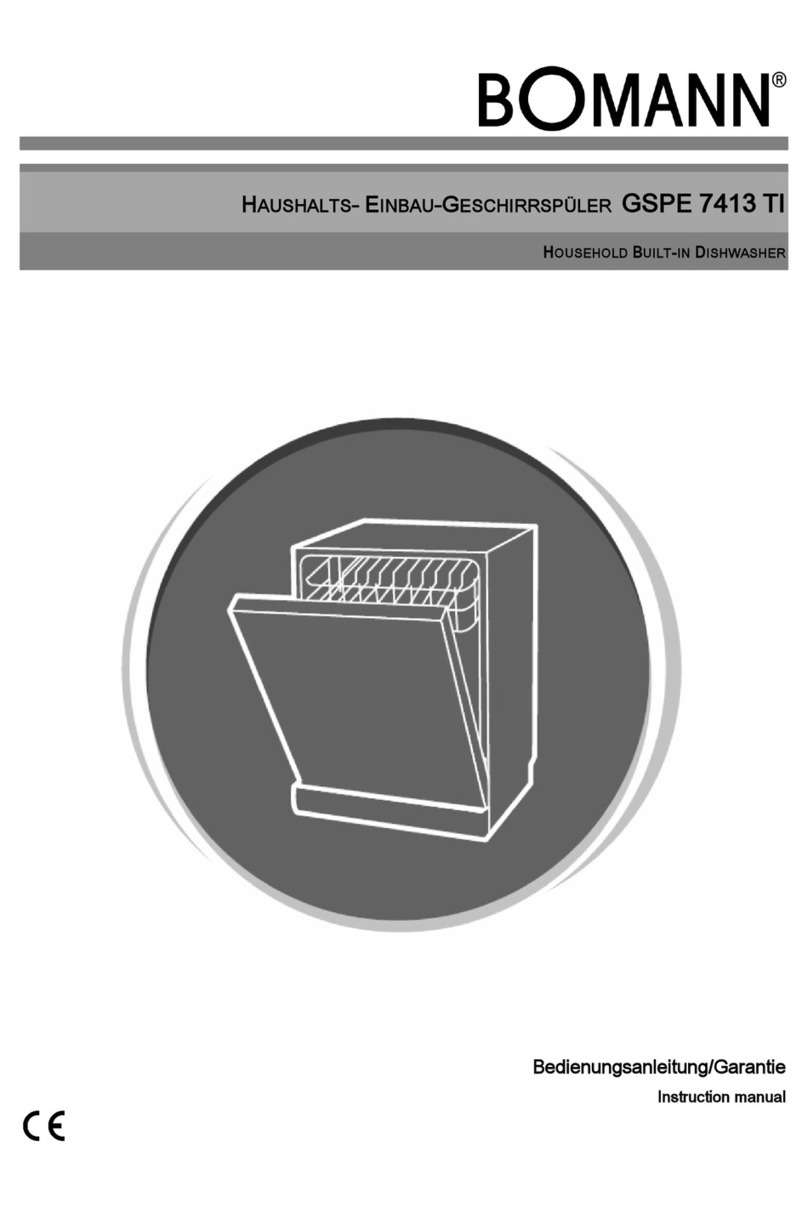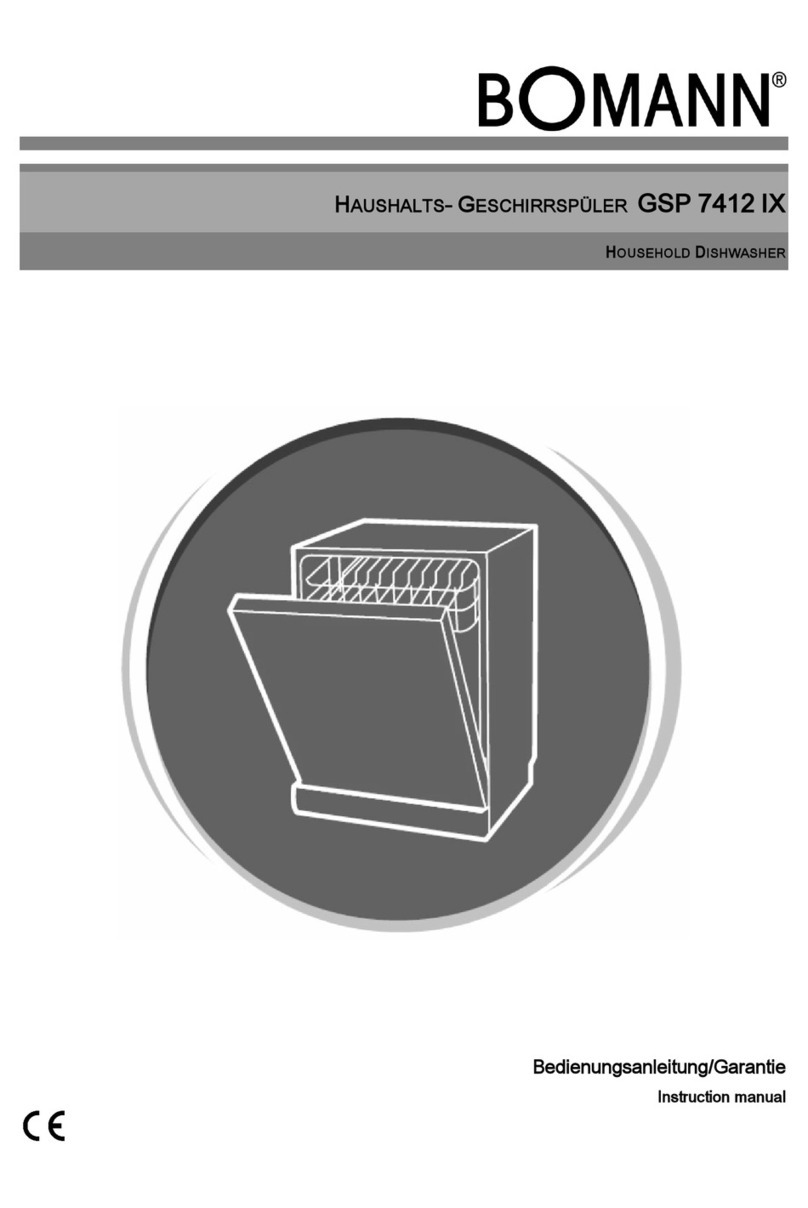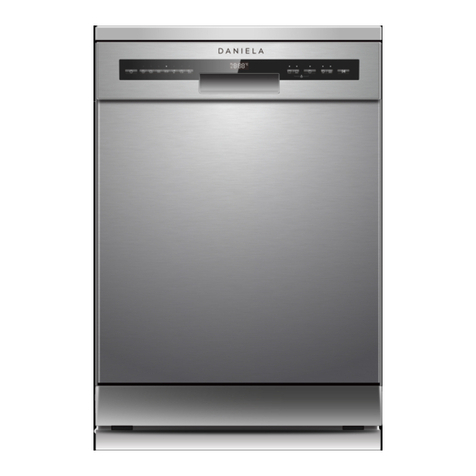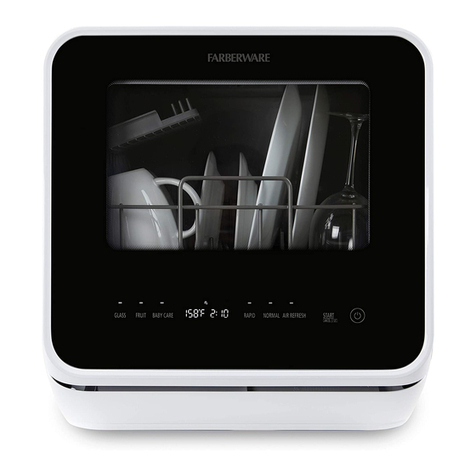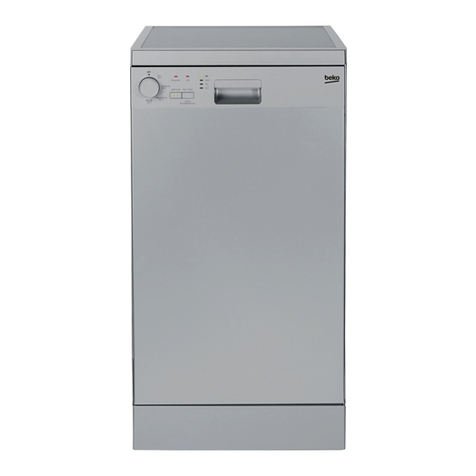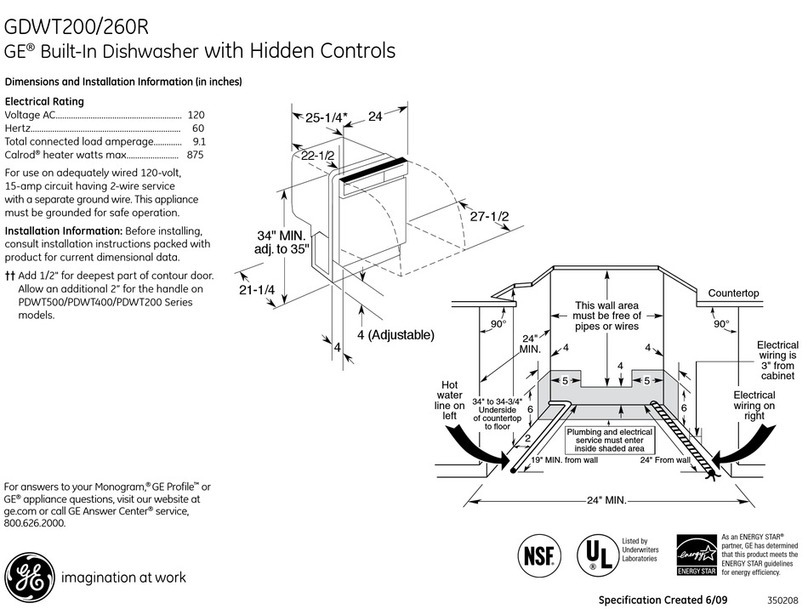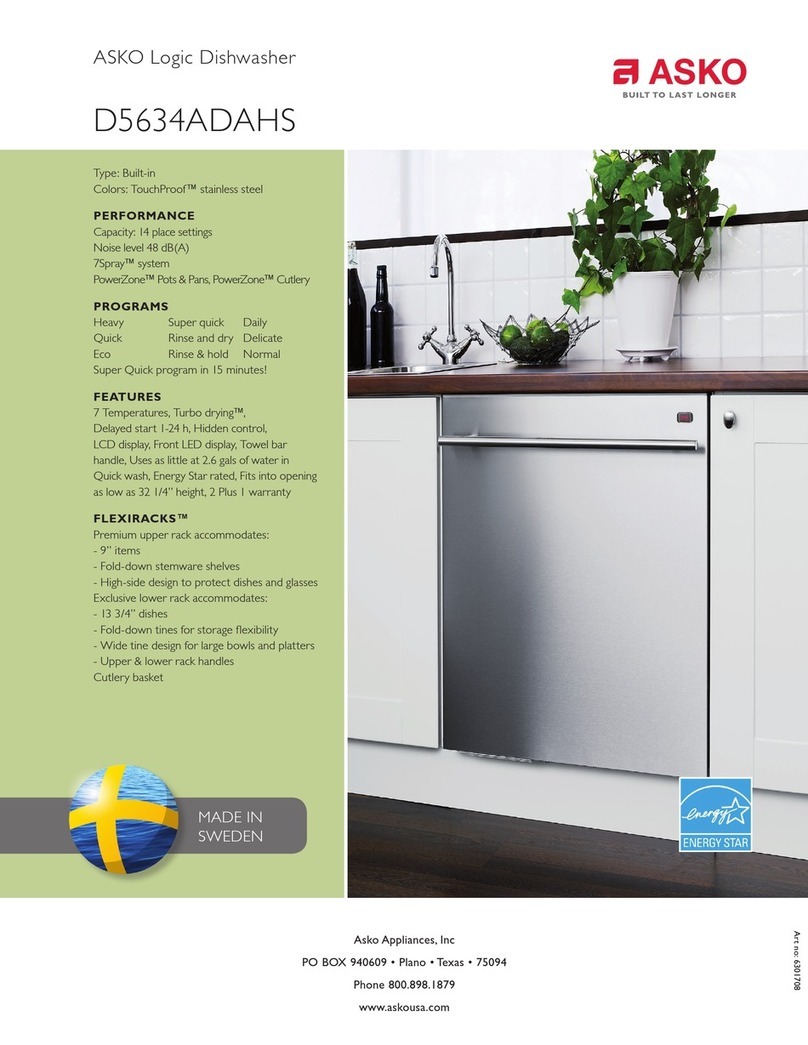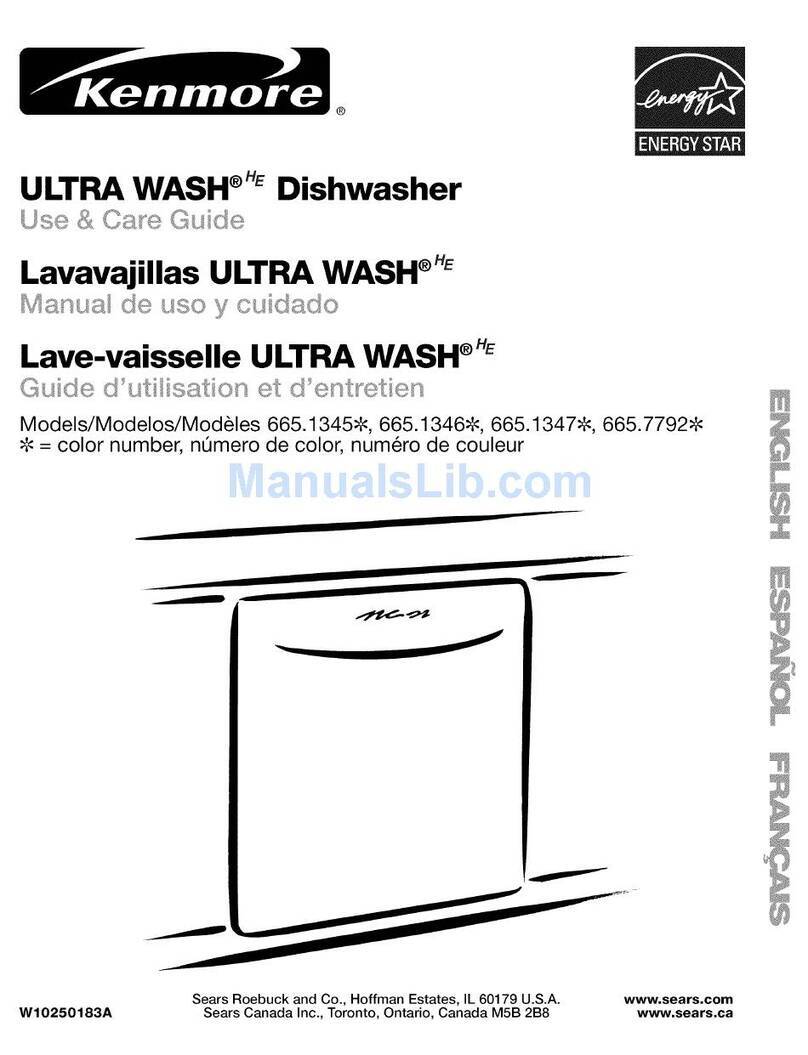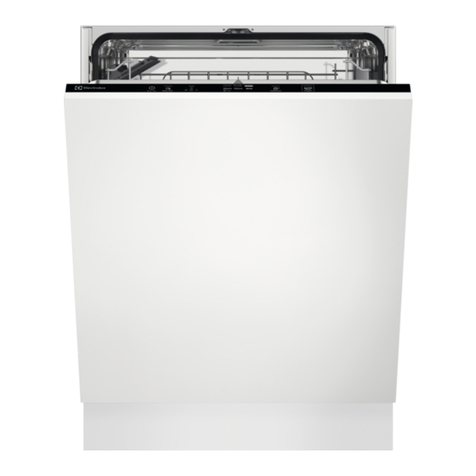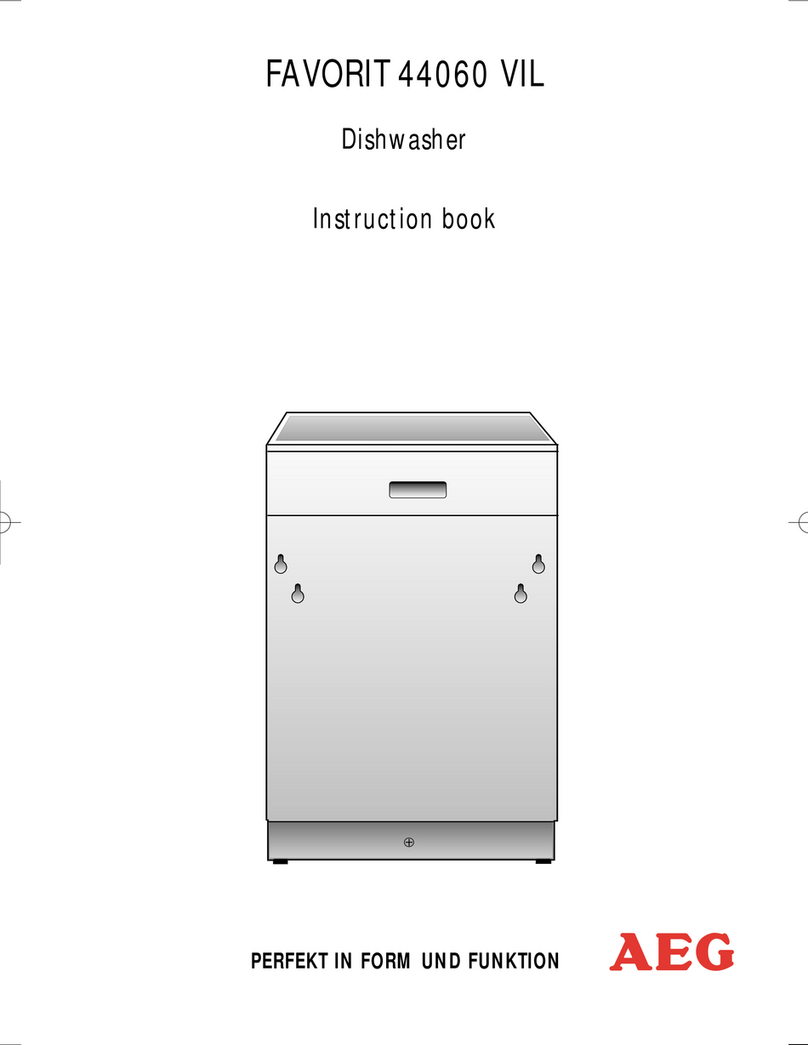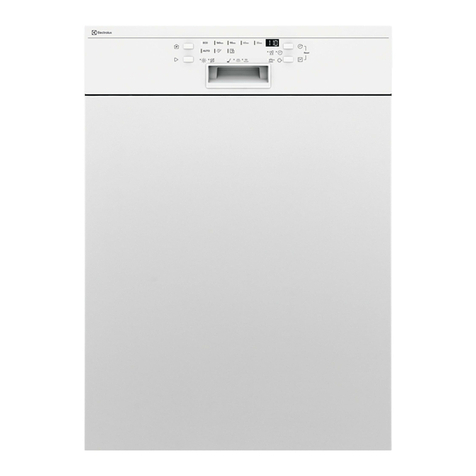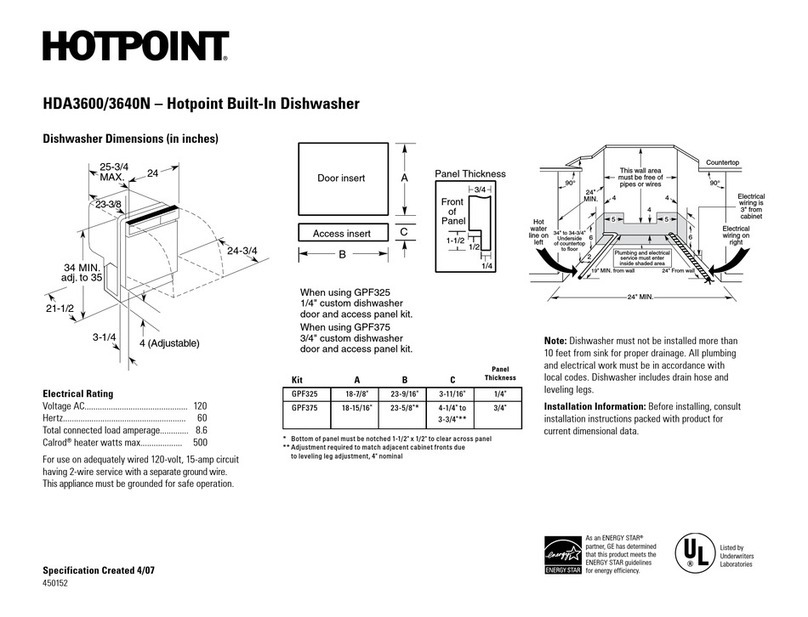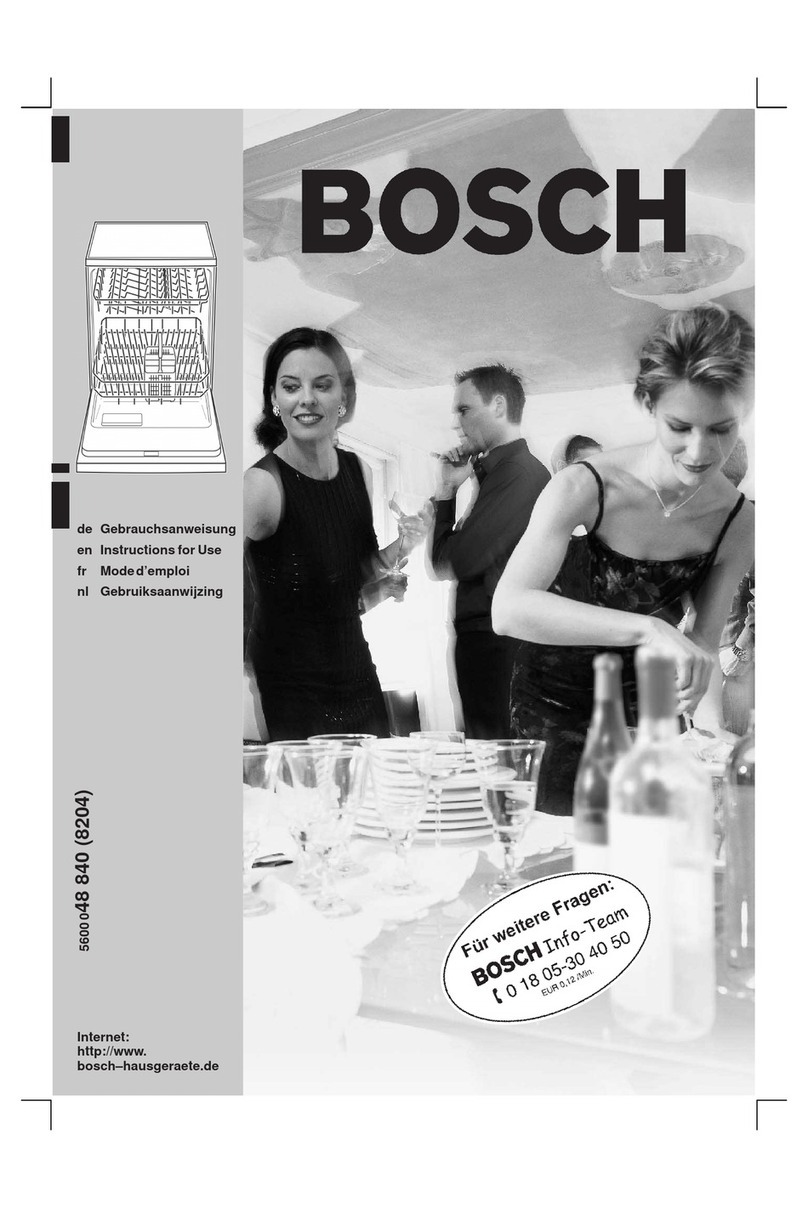BOMANN GSP 5703 User manual

1
12/2011
User Manual
HOUSEHOLD-DISHWASHER
GSP 5703
Please read this manual carefully and keep for future reference!

2
12/2011
OVERVIEW
Please read this user manual carefully before using the appliance. This user manual
contains important information for installation, operation and maintenance. An improper
using can be dangerous especially for children. Please keep all documents in a safe
place for future reference. Pass it on to any subsequent owner of the appliance.
The device must be transported and moved in an upright position and if necessary the unit can be
tilted slightly.
Before calling a professional technician
- the section on Troubleshooting Tips will help you to solve some common problems by yourself.
- If you can not solve the problems by yourself, please ask for the help of professional technicians.
NOTE: The manufacturer, following a policy of constant development and up-dating of the prod-
uct, may make modifications without giving prior notice.
TABLE OF CONTENT
1. Safety Precautions .............................................................................................................................3
2. Disposal of Used Appliances ............................................................................................................4
3. Operation Instruction .........................................................................................................................5
Control Panel........................................................................................................................................................5
Dishwasher Features ...........................................................................................................................................5
4. Prior Using for the First Time............................................................................................................6
A. Water Softener.................................................................................................................................................6
B. Fill in the Salt into the Water Softener..............................................................................................................6
C. Fill the Rinse Aid Dispenser.............................................................................................................................7
D. Function of Detergent ......................................................................................................................................8
5. Loading the Dishwasher Baskets .................................................................................................. 10
Method for Loading Normal Dishes....................................................................................................................11
Cutlery Basket, Cutlery Shelf .............................................................................................................................12
6. Starting a Program .......................................................................................................................... 13
Cycle Table ........................................................................................................................................................13
Starting a Cycle..................................................................................................................................................13
Program Change................................................................................................................................................13
At the End of the Cycle.......................................................................................................................................14
7. Maintenance and Cleaning ............................................................................................................. 14
Filtering System..................................................................................................................................................14
Caring for the Dishwasher..................................................................................................................................15
8. Installation Instruction .................................................................................................................... 16
Positioning the Appliance...................................................................................................................................16
Water Connection...............................................................................................................................................16
Power Connection..............................................................................................................................................17
Start the Dishwasher..........................................................................................................................................18
9. Troubleshooting Tips...................................................................................................................... 18
Before Calling the Specialist ..............................................................................................................................18
Error Codes........................................................................................................................................................19
Technical Data ...................................................................................................................................................20

3
12/2011
1.
S
AFETY
P
RECAUTIONS
Please read all instruction and safety information carefully and follow them accordingly.
Please keep this manual with all information in a safe place for future reference!
Grounding Instructions
- This appliance must be grounded. In the event of a malfunction or breakdown, grounding will re-
duce the risk of an electric shock by providing a path of least resistance of electric current.
- This appliance is equipped with a cord having an equipment-grounding conductor and a grounding
plug.
ATTENTION:
- Improper connection of the equipment-grounding conductor can result in the risk of an electric
shock.
- Check with a qualified electrician or service representative if you are in doubt whether the appli-
ance is properly grounded. Do not modify the plug provided with the appliance; If it does not fit the
outlet a proper outlet must be installed by a qualified electrician.
Proper Use
- This device is intended for private use. The manufacturer is not reliable for any damage resulting
from improper or other then intended use.
- For safety reasons, alterations or modifications of the device are prohibited.
-
Use the dishwasher only for its intended function.
- Do not use the device outdoors.
- Do not abuse, sit on, or stand on the door or dish rack of the dishwasher and do not place any
heavy objects on or stand on the door when it is open. The appliance could tip forward.
- The open door or the pulled out dish racks should not be overly burdened or loaded.
-
The door should not be left open, since this could increase the risk of tripping.
- Do not touch the heating element during or immediately after use (this instruction is only applicable
to machines with a visual heating element).
-
Do not operate your dishwasher unless all
enclosure panels are properly in place.
-
Open
the door very carefully if the dishwasher is
operating, there is a risk of water squirting out.
- Do not wash plastic items unless they are marked dishwasher safe or the equivalent. For plastic
items not so marked, check the manufacturer's recommendations.
- When loading items to be washed:
1) Locate sharp items so that they are not likely to damage the door seal;
2) Warning: Knives and other utensils with sharp points must be loaded in the basket with their
points down or placed in a horizontal position.
- When using your dishwasher, you should prevent plastic items from coming into contact with the
heating element (this instruction is only applicable to machines with a visual heating element).
- Check that the detergent compartment is empty after completion of the wash cycle.
- Use only detergent and rinse additives designed for an automatic dishwasher.
- Never use soap, laundry detergent, or hand washing detergent. Keep these products out of the
reach of children.
- Dishwasher detergents are strongly alkaline, they
can be extremely dangerous if swallowed. Avoid
contact with skin and eyes and keep children away from the dishwasher when the door is open.
-
Keep children away from detergent and rinse aid, keep children away from the open door of the
dishwasher, there could still be some detergent left inside.
-
This appliance is not intended for use by persons (including children) with reduced physical, senso-
ry or mental capabilities, or lack of experience and knowledge, unless they have been given super-
vision or instruction concerning use of the appliance by a person responsible for their safety.
-
Children should be supervised to ensure that they do not play with the appliance.
-
During installation, the power supply must not be excessively or dangerously bent or flattened.
-
If the supply cord is damaged, it must be replaced by a qualified person in order to avoid a hazard.
Do not use the device with a damaged cable or plug.
-
Do not repair the device by yourself. Please contact authorized personnel. In order to avoid
hazards. A damaged mains cable must be replaced with an equivalent cable by a qualified
specialist.
-
The appliance is to be connected to the water mains using new hose sets and that old hose-sets
should not be reused.
-
The maximum number of place settings to be washed is 12.
-
The maximum permissible inlet water pressure is 1 Mpa.

4
12/2011
-
The minimum permissible inlet water pressure is 0.04 Mpa.
-
Remove the door to the washing compartment when removing an old dishwasher from service or
discarding it.
Unpacking
Check the device for any possible transport damage. Do not install a damaged device. In case of
damage, please contact your distributor.
Removing the transport protection
The device and parts of the interior are protected for transport. Remove all adhesive tapes. You may
remove adhesive residue with a cleaning solvent. Also remove any adhesive tapes and packaging
materials from the inside of the device.
2. DISPOSAL OF USED APPLIANCES
This product is marked in accordance with the European waste regulation
2002 / 96 / EC - WEEE
It regulates the proper disposal of the product. Environmentally friendly disposal will pre-
vent possible negative consequences to health caused by improper disposal.
This symbol on the product or its packaging indicates that this product must not be dis-
posed of with the regular household waste. The user has to return the product to a collection point for
the recycling of electric and electronic equipment.
The disposal must comply with the local regulations in place.
For further information please contact your local authorities or waste collection service.
Disable waste equipment before disposal:
- Disconnect the mains plug from the wall socket.
- Disconnect the plug from the mains cable.
- Remove or disable any existing spring or latch locks.
This will prevent children from locking themselves (risk of suffocation!) or from getting into perilous
situations. Children might not understand the risks that arise from handling household devices.
Therefore, observe children and make sure they do not play with the device.
Environmental protection
- Do not use excessive detergents.
- Decontaminant and bleacher can be used to pre-treat the stains on the clothes only when very
necessary.
Packaging material
The packaging for transportation of the device and individual parts is produced of recyclable materials.
- corrugated cardboard / paperboard (mainly of waste paper)
- form part of PS (foamed, CFC-free polystyrene)
- Films and bags of PE (polyethylene)
- Strapping strips of PP (polypropylene)
IMPORTANT
Make sure you dispose of packaging materials environmentally friendly.

5
12/2011
3.
O
PERATION
I
NSTRUCTION
IMPORTANT: To get the best performance from your dishwasher, read all operation instructions
carefully before using it for the first time.
Control panel
Dishwasher Features
1 On/Off button and control lamp: to turn on/off
the power supply. The lamp shows the power
supply.
2 Start delay: by pressing this button the pro-
gram start can be delayed for 3/6/9h.
The corresponding control lamp shows the
selected time:
Press one time = 3h delay
Press two times = 6h delay
Press three times = 9h delay
Press four times = cancel the delay se-
lection
3 Child lock: press and hold the program buttons
INTENSIV and SCHNELL for around 3 sec. in or-
der to lock and/or unlock the dishwasher controls.
The corresponding program lamps lights up
and/or off.
4 Start/Pause button: to start/pause the select-
ed/running program.
5 Rinse aid- warning lamp lights up, when the
dispenser need to be refilled.
6 Salt- warning lamp lights up, when the soften-
er needs to be refilled.
7 Program buttons: to select one of three programs.
1 Upper basket
2 Spray arms
3 Lower basket
4 Water softener
5 Detergent dispenser
6 Rinse aid dispenser
7 Cutlery shelf

6
12/2011
4.
P
RIOR
U
SING FOR THE
F
IRST
T
IME
Before using your dishwasher for the first time:
A. Set the water softener
B. Pour 800 ml of water inside the salt container and then fill with dishwasher salt.
C. Fill the rinse aid dispenser.
D. Fill detergent in.
A. Water Softener
The water softener must be set manually, using the water hardness dial.
The water softener is designed to remove minerals and salts from the water, which would have a det-
rimental or adverse effect on the operation of the appliance. The higher the content of these minerals
and salts, the harder the water is. The softener should be adjusted according to the hardness of the
water in your area. Your local Water Authority can advise you on the hardness of the water in your
area.
Adjusting Salt Consumption
The dishwasher is designed to allow for adjusting the amount of salt consumed based on the hard-
ness of the water used. This is intended to optimize and customize the level of salt consumption so
that the salt consumption could be set proceed as follows:
It is recommended that adjustments should be made in accordance with the following schema:
Waterhardness Selector posi-
tion
Salt
consumption
(gram/cycle)
Autonomy
(cycles/2kgs)
°dH °fH °Clark mmol/l
0 - 10 0 - 17 0 - 12.5 0 - 1.7 / 0 /
10 - 25 17 - 44 12.5 - 31.3 1.7 - 4.4 - 20 60
25 - 50 44 - 89 31.3 - 62.5 4.4 - 8.9 Mid 40 40
>50 >89 >62.5 >8.9 + 60 25
Note: 1
°dH = 1,25 °Clark = 1,78 °fH = 0,178 mmol/l
°dH: German degree
°fH: French degree
°Clark: British degree
Note: 2
„/“ No salt need added
„-“ Setting toward the sign „-“
„+“ Setting toward the sign „+“
„Mid“ Setting between toward the sign „-“ and „+“
Contact your local water board for information on the hardness of your water supply.
Water Softener
The hardness of the water varies from place to place. If hard water is used in the dishwasher, deposits
will form on the dishes and utensils. The appliance is equipped with a special softener that uses salts
specifically designed to eliminate lime and minerals from the water.
B. Fill in the Salt into the Water Softener
Always use the salt intended for use with dishwasher.
The salt container is located beneath the lower basket and should be filled as explained in the follow-
ing:
ATTNTION
- Only use salt specifically designed for use in dishwashers. All other types of salt not specifically
designed for use in a dishwasher, especially table salt, will damage the water softener. In case of
damages caused by the use of unsuitable salt the manufacturer does not give any warranty nor is
liable for any caused damages.
1. Unscrew the cap from the salt container.
2. There is a ring on the container with an arrow on it (see figure to the side).
If necessary, rotate the ring in the anticlockwise direction from the "-" setting to-
wards the "+" sign, based on the hardness of the water being used.

7
12/2011
- Only fill with salt just before starting one of the complete washing programs. This will prevent any
grains of salt or salty water, which may have been split, remaining on the bottom of the machine for
any period of time, which may cause corrosion.
A. Remove the lower basket and then unscrew and remove the cap from the salt container
(pic. 1)
.
B. If you are filling the container for the first time, fill 800 ml of its volume with water.
C. Place the end of the funnel (supplied) into the hole and introduce about 1.5 kg of salt. It is normal
for a small amount of water to come out of the salt container
(pic. 2)
.
D. Carefully screw the cap back on.
E. Usually, the salt warning light will be off in 2-6 days after the salt container is filled with salt.
F. Immediately after filling the salt into the salt container, a washing program should be started (we
suggest to use the rapid program). Otherwise the filter system, pump or other important parts of the
machine may be damaged by salty water. This is out of warranty.
NOTE:
- The salt container must be refilled when the salt warning light in the control panel lights up. Though
the salt container is filled enough, the indicator light may not black out before the salt fully dissolve.
If there is no salt warning light in the control panel (for some models), you can judge when to load
the salt into the softener by the cycles that the dishwasher had run (see the following schema).
- If there are spills of the salt, a program (rapid) could be run to wipe them out.
C. Fill the Rinse Aid Dispenser
Function of Rinse Aid
Rinse aid is automatically added during the last rinse, ensuring thorough rinsing, spot and streak free
drying.
ATTENTION: Only use branded rinse aid for dishwasher. Never fill the rinse aid dispenser with
any other substances (e.g. dishwasher cleaning agent, liquid detergent). This would damage the ap-
pliance.
When to Refill the Rinse Aid Dispenser
If there is no rinse-aid warning light on the control panel, you can judge the amount of rinse-aid by the
color of the optical level indicator "D" located next to the cap. When the rinse-aid container is full the
whole indicator will be dark. As the rinse aid diminishes, the size of the dark dot decreases.
You should never let the rinse aid get below 1/4 full.
As the rinse aid diminishes, the size of the black dot on the rinse aid level indicator changes, as illus-
trated below.
full
¾ full
½ full
¼ full – refill to eliminate spotting
empty
D
(
Rinse aid indicator
)

8
12/2011
Rinse Aid Dispenser
1. To open the dispenser; turn the cap to the "open" (left) arrow and lift it out.
2. Fill the rinse aid into the dispenser, be careful not to overfill.
3. Replace the cap by inserting it aligned with "open" arrow and turning it to the "closed" (right) arrow.
The rinse aid is released during the final rinse to prevent water from forming droplets on your dishes
that can leave spots and streaks. It also improves drying by allowing water to sheet off the dishes.
Your dishwashers are designed to use liquid rinse aids. The rinse aid dispenser is located inside the
door next to the detergent dispenser.
To fill the dispenser, open the cap and pour the rinse aid into the dispenser until the level indicator
turns completely black. The volume of the rinse aid container is about 140 ml. Be careful not to overfill
the dispenser, because this could cause over sudsing.
NOTE: Clean up any rinse aid spilled while during filling with an absorbent cloth to avoid exces-
sive foaming during the next wash. Don't forget to replace the cap before you close dishwasher door.
Adjusting Rinse Aid Dispenser
NOTE: Increase the dose if there are drops of water or lime spots on the dishes after washing.
Reduce it if there are sticky whitish streaks on the dishes or a bluish film on glassware or knife blades.
D. Function of Detergent
Detergents with its chemical ingredients are necessary to remove dirt, crush dirt and transport it out of
the dishwasher. Most of commercial quality detergents are suitable for this purpose.
Detergent
There are 3 sorts of detergents
1. With phosphate and with chlorine
2. With phosphate and without chlorine
3. Without phosphate and without chloride
Normally new pulverized detergent is without phosphate. The water softener function of phosphate is
not given. In this case we recommend to fill salt in the salt container even when the hardness of water
is only 6°dH. If detergents without phosphate were used in case of hard water often white spots ap-
pear at dishes and glasses. In this case please add more detergent to reach better results. Detergents
without chlorine do only bleach a little. Strong and colored spots will not removed completely. In this
case please choose a program with higher temperature.
Concentrated Detergent
Based on their chemical composition, dishwasher can be split in two basic types:
- conventional, alkaline detergents with caustic components
- low alkaline concentrated detergents with natural enzymes
The use of "normal" washing programs in conjunction with concentrated detergents reduces pollution
and is good for your dishes; these washing programs are specially matched to the dirt- dissolving
properties of the enzymes of the concentrated detergent. For this reason "normal" washing programs
in which concentrated detergents are used can achieve the same results that can otherwise only be
achieved using "intensive" programs.
Adjust Lever
(Rinse)
The rinse aid dispenser has six settings. Always start with the dispenser set on
"4". If spots and poor drying are problems, increase the amount of rinse aid
dispensed by removing the dispenser lid and rotating the dial to "5”. If the dish-
es still are not drying properly or are spotted, adjust the dial to the next higher
number until your dishes are spot-free. The dose is factory set in position 5.

9
12/2011
Detergent Tablets
Detergent tablets of different brands dissolve at different speeds. For this reason some detergent can-
not dissolve and develop their full cleaning power during short programs.
Therefore please use long programs when using detergent tablets, to ensure the complete removal of
detergent residuals.
Detergent Dispenser
The dispenser must be refilled before the start of each washing cycle following the instructions provid-
ed in the Wash Cycle Table. Your dishwashers use less detergent and rinse aid than conventional
dishwashers. Generally, only one tablespoon of detergent is needed for a normal wash load. Also,
more heavily soiled items need more detergent. Always add the detergent just before starting dish-
washer, otherwise it could get damp and will not dissolve properly.
Amount of Detergent to Use
NOTE:
- If the lid is closed: press release button. The lid springs open.
- Always add the detergent just before starting each wash cycle.
- Only use branded detergent aid for dishwasher.
WARNING: Dishwasher detergent is corrosive! Take care to keep it out of reach of children.
Proper Using of Detergent
Use only detergent specifically made for use in dishwashers. Keep your detergent fresh and dry. Don't
put powder detergent into the dispenser until you're ready to wash dishes.
Fill in the Detergent
Fill the detergent dispenser with detergent. The marking indicates the dos-
ing levels, as illustrated on the right:
1. The place of main wash cycle detergent placed, "MIN" means approxi-
mately 20 g of detergent.
2. The place of pre-wash cycle detergent placed, approximately 5 g of de-
tergent.
Please observe the manufacturer's dosing and storage recommendations as stated on the detergent
packaging. Close the lid and press until it locks in place.
If the dishes are heavily soiled, place an additional detergent dose in the pre-wash detergent chamber.
This detergent will take effect during the pre-wash phase.
NOTE:
- You find information about the amount of detergent for the single program on the last page.
- Please be aware that according to the level soiling and the specific hardness of water, differences
are possible.
- Please observe the manufacturer's recommendations on the detergent packaging.

10
12/2011
5.
L
OADING THE
D
ISHWASHER
B
ASKETS
Recommendation
- Consider buying utensils which are identified as dishwasher-proof.
- Use a mild detergent that is described as 'kind to dishes'. If necessary, seek further information
from the detergent manufacturers.
- For particular items, select a program with as low a temperature as possible.
- To prevent damage, do not take glass and cutlery out of the dishwasher immediately after the pro-
grams has ended.
For rinsing in the dishwasher the following cutlery/dishes
Attention before and after the loading of dishwasher baskets
For best performance of the dishwasher, follow these loading guide lines.
Features and appearance of baskets and cutlery baskets may vary from your model.
Scrape off any large amounts o f leftover food. Soften remnants of burnt food in pans.
It is not necessary to rinse the dishes under running water.
Place objects in the dishwasher in following way:
1. Items such as cups, glasses, pots /pans, etc. are faced downwards.
2. Curved items, or ones with recesses, should be loaded aslant so that water can run off.
3. All utensils are stacked securely and can not tip over.
4. All utensils are placed in the way that the spray arms can rotate freely during washing.
NOTE: Very small items should not be washed in the dishwasher as they could easily fall out of
the basket.
- Load hollow items such as cups, glasses, pans etc. with the opening facing downwards so that
water can not collect in the container or a deep base.
- Dishes and items of cutlery must not lie inside one another, or cover each other.
- To avoid damage to glasses, they must not touch.
- Load large items which are most difficult to clean into the lower basket.
- The upper basket is designed to ho ld more delicate and lighter dishware such as glasses, coffee
and tea cups.
- Long bladed knives stored in an upright position are a potential hazard!
- Long and/or sharp items o f cutlery such as carving knives must be positioned horizontally in the
upper basket.
- Please do not overload your dishwasher. This is important for good results and for reasonable con-
sumption of energy.
Removing the Dishes
To prevent water dripping from the upper basket into the lower basket, we recommend that you empty
the lower basket first and then the upper basket
are not suitable:
- Cutlery with wooden, horn china or mother-of-
pearl handles
- Plastic items that are not heat resistant
- Older cutlery with glued parts that are not
temperature resistant
- Bonded cutlery items or dishes
- Pewter or cooper items
- Crystal glass
- Stell items subject to rusting
- Wooden platters
- Items made from synthetic fibres
-
are limited suitable:
- Some types of glasses can become dull
after a large number of washes
- Silver and aluminum parts have a tendency
to discolor during washing
- Glazed patterns may fade if machine
washed frequently

11
12/2011
Method for Loading Normal Dishes
Loading the upper basket: The upper basket is designed to hold more delicate and lighter dishware
such as glasses, coffee and tea cups and saucers, as well as plates, small bowls and shallow pans
(as long as they are not too dirty). Position the dishes and cookware so that they will not get moved by
the spray o f water
Adjusting the Upper Basket
The height of the upper basket can be adjusted in order to create more space for large utensils both
for the upper/lower basket. The height of the upper basket can be adjusted by placing the wheels on
different h eight of the rails. Long items, serving cutlery, salad servers and knives should be placed on
the shelf so that they do not obstruct the rotation of the spray arms. The shelf can be folded back or be
removed when not required for use.
Loading the lower basket: We suggest that you place large items and the most difficult to clean
items are to be placed into the lower basket: such as pots, pans, lids, serving dishes and b owls, as
shown in the figure below. It is preferable to place serving dishes and lids on the side of the racks in
order to avoid blocking the rotation of the top spray arm.
Please be reminded that:
- Pots, serving bowls etc. must always be placed top down.
- Deep pots should be slanted to allow water to flow out.
- The Bottom Basket features folding spikes so that larger or more pots and pans can be loaded.
A Cups
B Glasses
C Saucer
D Serving bowl
E Serving bowl
F Serving bowl
G Soup plates
H Dinner plates
I Dessert plates
J Oval plate

12
12/2011
Folding Racks of the lower Basket
Cutlery Basket, Cutlery Shelf
Cutlery should be placed in the cutlery basket with the handles at the bottom. If the rack has side bas-
kets, the spoons should be loaded separately into the appropriate slots, especially long utensils should
b e placed in the horizontal position at the front of the upper basket as shown in the picture
Example for loading:
Cutlery Shelf
Cutlery
Basket
For personally safety and a top quality cleaning, place the cutlery in the basket and make sure:
- They do not nest together.
- Silverware is placed with the handles-down.
- But place knives and other potentially dangerous utensils with handles-up.
WARNING: Do not let any item extend through the bottom.
For better stacking of pots and pans, the spikes can
be folded down as show in the picture.
1. Tea spoons
2. Dessert spoons
3. Soup spoons
4. Gravy ladle
5. Serving fork
6. Forks
7. Knives
8. Serving sppons

13
12/2011
6.
S
TARTING A
P
ROGRAM
Cycle Table
Program Cycle Selection In-
formation
Description of
Cycle
Detergent
Pre/main
Running
Time
(Min.)
Energy
(kWh)
Water
(l)
Intensive
For the heaviest soiled
loads, such as pots,
pans, casserole dishes
and dishes that have
been sitting with dried
food on them for a
while.
Pre-wash
Main wash (60°C)
Rinse
Rinse2
Hot rinse
Drying
5/25 g
(or Tablets w/o
the addition of
rinse aid)
180 1.30 16
Normal
(*EN 50242)
For normally soiled
loads, such as pots,
plates, glasses and
lightly soiled pans,
standard daily cycle.
Pre-wash Rinse
Main wash (46°C)
Rinse
Hot rinse
Drying
5/25 g
(or Tablets w/o
the addition of
rinse aid)
162 1.03 13
Rapid
A shorter wash for
lightly soiled loads that
do not need drying.
Main wash (40°C)
Hot rinse 15 g 39 0.50 7
NOTE: *EN 50242: this program is the test cycle.
The information for comparability test in accordance with EN 50242, as follows:
- Capacity: 12 settings
- Position upper basket: upper wheels on rails
- Rinse aid setting: 5
- The power consumption: off-mode 0.39 W
left-on mode: 0.50 W
Starting a Cycle
- Draw out the lower and upper basket, load the dishes and push them back. It is commended to
load the lower basket first, then the upper one (see section “Loading the Baskets”).
- Pour in the detergent (see section “Salt, Detergent and Rinse Aid”).
- Insert the plug into the socket. The power supply is 220-240 VAC /50 HZ, the specification of the
socket is 10A 250VAC. Make sure that the water supply is turned on to full pressure.
- Close the door, press the ON/OFF button and the ON/OFF lamp will turn on.
- Press the program button, the program will be changed in the following direction:
Intensive>Normal>Rapid
If a program is selected, the response lamp will light.
- Then press the Start/Pause button, the dishwasher begins to start.
NOTE: A click could be heard when the door is closed perfectly.
Program Change
Premise:
- A cycle that is underway can only be modified if it has only been running for a short time. Otherwise
the detergent may have already been released and the appliance may have already drained the
wash water. If this is the case, the detergent dispenser must be refilled (see section "Fill in the De-
tergent").
- Pls. press the on/off button to cancel the program, press the on/off button to restart the machine,
select the new program and press the start/pause button.
- The program lamps shows the state of the dishwasher:
a) all program lamps off_ _ _ _ _ _ _ _ _ _ _ _ _ _ _program finished
b) one of the program lamp on_ _ _ _ _ _ _ _ _ _ _ _cycle running
c) one of the program lamp blinking_ _ _ _ _ _ _ _ _ _pause
NOTE: If you open the door when washing, the machine pauses and warning alarm rings.
When you close the door, the machine will keep on working after 10 seconds.

14
12/2011
Forgot to Add a Dish?
Forgotten dishes can be added any time before the detergent container opens.
At the End of the Cycle
When the working cycle has finished, the buzzer of the dishwasher will sounds six times
Turn off the dishwasher
- Turn of the appliance by pressing the ON/OFF button.
- Shut off the water supply!
Open the door carefully
Hot dishes are sensitive to knocks. The dishes should therefore be allowed to cool down around 15
minutes before removing from the appliance.
Open the dishwasher's door, leave it ajar and wait a few minutes before removing the dishes. In this
way they will be cooler and the drying will be improved.
Unloading the dishwasher
It is normal that the dishwasher is wet inside.
Empty the lower basket first and then the upper one. This will avoid water dripping from the upper
Basket onto the dishes in the lower one.
WARNING: It is dangerous to open the door when washing, because the hot water may scald
you.
7.
M
AINTENANCE
A
ND
C
LEANING
Filtering system
The filter prevents larger remnants of food or other objects from getting inside the pump.
The residues may block the filter, in this case they must be removed.
The filter system consists of a coarse filter, a flat (main) filter and a microfilter.
Flat filter
Food and soil particles trapped in this filter are pulverized by a special jet on the lower
spray arm and washed down to drain.
Coarse filter
Larger items, such as pieces of bones or glass, that could block the drain are trapped
in the coarse filter. To remove the items caught by the filter, gently squeeze the tap
on the top of this filter and lift out.
Micro filter
This filter holds soil and food residues in the sump area and prevents it from being
redeposit on the dishes during wash cycle.
Filter assembly
The filter efficiently removes food particles from the wash water, allowing it to be recycled during the
cycle. For best performance and results, the filter must be cleaned regularly. For this reason, it is a
good idea to remove the larger food particles trapped in the filter after e ach was h cycle by rinsing the
semicircular filter and cup under running water. To remove the filter device, pull the cup handle in the
upward direction.
WARNING:
- The dishwasher must never be used without the filters.
- Improper replacement of the filter may reduce the performance level of the appliance and damage
dishes and utensils.
1. Open the door a little to stop the program.
2. After the spray arms stop working, you can open
the door completely.
3. Add forgotten dishes.
4. Close the door.
5. The dishwasher restart the work after approx. 10
seconds.

15
12/2011
By unscrewing the coarse filter, you can remove the filter system.
NOTE: When following this procedure from step1 to step 2, the filter system will be removed;
when following it from Step 2 to Step 1, the filter system will be installed.
- Inspect the filters for blocking after every time the dishwasher has been used.
- By unscrewing the coarse filter, you can remove the filter system. Remove any food remnants and
clean the filters under running water.
REMARK: The entire filter assembly should be cleaned once a week.
Cleaning the Filter
To clean the coarse filter and the fine filter, use a c leaning brush. Reassemble the filter parts as
shown in the figures on the last page and reinsert the entire assembly in the dishwasher, positioning it
in its seat and pressing downwards.
WARNING: When cleaning the filters, don't knock on them. Otherwise, the filters could be con-
torted and the performance of the dishwasher could be decreased.
Caring for the Dishwasher
The control panel can be cleaned by using a lightly dampened cloth.
After cleaning, make sure to dry it thoroughly. For the exterior, use a good appliance polish wax.
Never use sharp objects, scouring pads or harsh cleaners on any part of the dishwasher.
Cleaning the Door
To clean the edge around the door, you should use only a soft warm, damp cloth.
To avoid penetration o f water into the door lock and electrical components, do not use a spray cleaner
of any kind.
WARNING:
- Never use a spray cleaner to clean the door panel as it may damage the door lock and electrical
components.
- Abrasive agents or some paper towels should not be used because of the risk of scratching or
leaving spots on the stainless steel surface.
Protect against Freezing
Pls. take frost protection measures on the dishwasher in winter. Every time after washing cycles, pls.
operate as follows:
1. Cut off the electrical power to the dishwasher.
2. .Turn off the water supply and disconnect the water inlet pipe from the water valve.
3. Drain the water from the inlet pipe and water valve (use a pan to catch the water).
4. Reconnect the water inlet pipe to the water valve.
5. Remove the filter at the bottom of the tub and use a sponge to soak up water in the sump.
NOTE: If your dishwasher cannot work because of the ice, please contact professional service
persons.
Cleaning the Spray Arms
It is necessary to clean the spray arms regularly for hard water chemicals will
clog the spray arm jets and bearings.
To remove the upper spray arm, screw off the nut clockwise then remove the
arm.
To remove the lower spray arm, pull out the spray arm upward. Wash the arms
in soapy and warm water and use a soft brush to clean the jets. Replace them
after rinsing them thoroughly.
Step 1: Turn the coarse filter anti-
clockwise and lift it up.
Step 2: Lift the flat filter up.

16
12/2011
How to keep your Dishwasher in Shape
8.
I
NSTALLATION
I
NSTRUCTION
The dishwasher should not stand on top of the water hoses or the electricity supply cable and the in-
stallation of the pipes and electrical equipments should be done by professionals.
WARNING
Electrical Shock Hazard! Disconnect electrical power before installing dishwasher.
Failure to do so can result in death or electrical shock.
Positioning the Appliance
Position the appliance in the desired location. The back should rest against the wall behind it, and the
sides, along the adjacent cabinets or walls. The dishwasher is equipped with water supply and drain
hoses that can be positioned either to the right or the left sides to facilitate proper installation.
The power cord should be easily accessible.
The dishwasher can be installed under a working cover by following the steps of the below picutres.
Leveling the Appliance
Once the appliance is positioned for leveling, the height of the dishwasher may be altered via adjust-
ment of the screwing level of the feet. In any case, the appliance should not be inclined more than 2°.
The max. adjusting height of the feet is 20 mm.
If the appliance is leveled correctly, it will be more stable and much less likely to move or cause vibra-
tions and noise while it is operation.
Water Connection
The water pressure must be between 0.04 MPa and 1 MPa. Is the pressure lower or higher pls. con-
tact a technical specialist.
Cold Water Connection
ACHTUNG: The appliance is to be connected to the water mains using new hose sets and that
old hose-sets should not be reused.
-
After Every Wash
After every wash, turn off the water supply to the
appliance and leave the door slightly open so that
moisture and odours are not trapped inside.
- Remove the Plug
Before cleaning or performing maintenance, al-
ways remove the plug from the socket.
- No Solvents or Abrasive Cleaning
To clean the exterior and rubber parts of the dish-
washer, do not use solvents or abrasive cleaning
products. Only use a cloth with warm soapy water.
To remove spots or stains from the surface of the
interior, use a cloth dampened with water a n a lit-
tle vinegar, or a cleaning product mad e specifical-
ly for dishwashers.
-
When not in Use for a Long Time
It is recommend that you run a was h cycle with
the dishwasher empty and the n remove the plug
from the socket, turn off the water supply and
leave the door of the appliance slightly open. This
will help the door seals to last longer and prevent
odours from forming within the appliance.
- Moving the Appliance
If the appliance must be moved, try to keep it in the
vertical position. If absolutely necessary, it can be
positioned on its back.
- Seals
One of the factors that cause odours to form in the
dishwasher is food that remains trapped in the
seals. Periodic cleaning with a damp sponge will
prevent this from occurring.

17
12/2011
Connect the cold water supply hose to a threaded 3/4(inch) connector and make
sure that it is fastened tightly in place. If the water pipes are new or have not been
used for an extended period of time, let the water run to make sure that the water is
clear. This precaution is needed to avoid the risk of the water inlet to be blocked and
damage the appliance.
Hot Water Connection
The water supply to the appliance can also be connected to the house hot water line (centralized sys-
tem, heating system), as long as it does not exceed a temperature of 60 C. In this case, the wash
cycle time will be shortened and the wash efficiency slightly reduced.
The connection must be made to the hot water line following the same procedures as those for the
connection to the cold water line.
WARNING: To avoid that water pressure remains in the inlet hose, please close the hydrant after
using.
Drain Hose Connection
Insert the drain hose into a drain pipe with a minimum diameter of
40 mm, or let it run into the sink, making sure to avoid bending or
crimping it. Use the special plastic hinge that comes with the ap-
pliance . The top of the hose must be at a height between 500
mm (min) and 1100 mm (max).
The free end of the hose must not be immersed in water to avoid
the back flow of it.
How to Drain Excess Water From Hoses
If the sink is 1100 mm higher from the floor, the excess water in hoses cannot be drained directly into
the sink. It will be necessary to drain excess water from hoses into a bowl or suitable container that is
held outside and lower than the sink.
Water Outlet
Connect the water drain hose. The drain hose must be correctly fitted to avoid water leaks.
Ensure that the water drain hose is not kinked or squashed.
Extension Hose
If you need a drain hose extension, make sure to use a similar drain hose.
It must be no longer than 4 meters; otherwise the cleaning effect of the dishwasher could be reduced.
Power Connection
WARNING for your personal safety:
- Do not use an extension cord or an adapter plug with this appliance.
- Do not, under any circumstances, cut or remove the earthing connection from the power cord.
Electrical Requirements
Please look at the rating label to know the rating voltage and connect the dishwasher to the appropri-
ate power supply. Use the required fuse 10 amp, time delay fuse or circuit breaker recommended and
provide separate circuit serving only this appliance.
Electrical Connection
Ensure the voltage and frequency of the power being corresponds to those on the rating plate. Only
insert the plug into an electrical socket which is earthed properly. If the electrical socket to which
the appliance must be connected is not appropriate for the plug , replace the socket, rather than using
a adaptors or the like as they could cause overheating and burns.
Grounding Instructions
This appliance must be earthed. In the event of a malfunction or breakdown, earthing will reduce the
risk of electric shock by providing a path of least resistance for the electric current. This appliance is
equipped with a cord having an equipment-earthing conductor and an earthing plug. The plug must be
plugged into an appropriate outlet that is installed and earthed in accordance with all local standards
and requirements.
WARNING:
- Improper connection of the equipment earthing conductor can result in the risk of an electric shock.

18
12/2011
- Check with a qualified electrician or service representative if you are in doubt whether the appli-
ance is properly earthed.
- Do not modify the plug provided with the appliance. If the plug does not fit properly to the outlet,
please have a qualified electrician to install a proper outlet.
- If the supply cord is damaged, it must be replaced by a qualified person in order to avoid a hazard.
Do not use the device with a damaged cable or plug.
Start the Dishwasher
The following things should be checked before starting the dishwasher:
- The dishwasher is level and fixed properly.
- The inlet valve is open.
- There is a leakage at the connections of the conducts.
- The wires are tightly connected.
- The power is switched on.
- The inlet and drain hoses are knotted.
- All packing materials and printings should be taken out from the dishwasher
ATTENTION: After installation, please make sure to keep this manual. The content of this manual
is very helpful to the users.
9.
T
ROUBLESHOOTING
T
IPS
Before Calling the Specialist
Reviewing the charts on the following pages may make you be free of calling for service.
Problem
Possible Causes
What
To Do
Dishwasher doesn't
run
Fuse blown, or the circuit
breaker acted
Replace fuse or reset circuit breaker. Remove any other appli-
ances sharing the same circuit with the dishwasher.
Power supply is not turned
on
Make sure the dishwasher is turned on and the door is closed
securely. Make sure the power cord is properly plugged into the
wall socket.
Water pressure is low Check that the water supply is connected properly and the water
is turned on.
Drain pump doesn't
stop Overflow The system is designed to detect an overflow. When it does, it
shuts off the circulation pump and turns on the drain pump.
Noise
Some sounds are normal Sound from detergent cup opening.
Utensils are not secure in
the baskets or something
small has dropped into the
basket
To ensure everything is secured in the dishwasher
Motor hums
Dishwasher has not been used regularly. If you do not use it
often, remember to set it to fill and pump out every week, which
will help keep the seal moist.
Suds in the tub Improper detergent
Use only the special dishwasher detergent to avoid suds.
If this occurs, open the dishwasher and let suds evaporate.
Add 4 l of cold water to the tub. Close and latch the dishwasher,
then start a short wash cycle to drain out the water.
Repeat if necessary.
Spilled rinse agent Always wipe up rinse agent spills immediately.
Stained tub interior
Detergent with colorant was
used Make sure that the detergent is the one without colorant.
Dishes and flatware
not clean
Improper program Select a stronger program.
Improper basket loading Make sure that the action of the detergent dispenser and spray
arms are not blocked by large dishware.
Spots and filming on
glasses and flatware
1. Extremely hard water
2. Low inlet temperature
3. Overloading the dish-
washer
4. Improper loading
5. Old or damp powder
detergent
6. Empty rinse agent dis-
penser
7. Incorrect dosage of
detergent
To remove spots from glassware:
1. Take out all metal utensils out of the dishwasher.
2. Do not add detergent.
3. Choose the longest cycle.
4. Start the dishwasher and allow it to run for about 18 to 22
minutes, then it will be in the main wash.
5. Open the door to pour 2 cups of white vinegar into the bottom
of the dishwasher.
6. Close the door and let the dishwasher complete the cycle.
If the vinegar does not work: Repeat as abov
e, except use 1/4
cup (60 ml) of citric acid crystals instead of vinegar.

19
12/2011
Problem
Possible Causes
What To Do
Cloudiness on
glassware
Combination of soft water
and too much detergent
Use less detergent if you have soft water and select a shortest
cycle to wash the glassware and to get them clean.
Yellow or brown film
on inside surfaces
Tea or coffee stains
Using a solution of 1/2 cup of bleach and 3 cups of warm water to
remove the stains by hand.
You have to wait for 20 minutes after a cycle to let the heating
elements cool down before cleaning interior; otherwise, burns will
happen.
Iron deposits in water can
cause an overall film You have to call a water softener company for a special filter.
White film on inside
surface Hard water minerals
To clean the interior; use a damp sponge with dishwasher deter-
gent and wear rubber gloves. Never use any other cleaner than
dishwasher detergent for the risk of foaming or suds.
The detergent dis-
penser lid cannot be
closed properly
Clogged detergent residue
is blocking the catch Clean the detergent from the catch.
Detergent left in
dispenser cups
Dishes block detergent
Cups Re-loading the dishes properly.
Steam Normal phenomenon There is some steam coming through the vent by the door latch
during drying and water draining.
Black or gray marks
on dishes
Aluminum utensils have
rubbed against dishes Use a mild abrasive cleaner to eliminate those marks.
Water standing on
the bottom of the tub
This is normal A small amount of clean water around the outlet on the tub bot-
tom keeps the water seal lubricated.
Dishwasher leaks
Overfill dispenser or rinse
aid spills
Be careful not to overfill the rinse aid dispenser. Spilled rinse aid
could cause oversudsing and lead to overflow
ing. Wipe away any
spills with a damp cloth.
Dishwasher isn't level Make sure the dishwasher is level.
Error Codes
When some malfunctions happen, the appliance will indicate error codes to warn you
LED’s Codes Meanings Possible Causes
LED 1 = Intenisve
LED 2 = Normal
LED 3 = Rapid
LED 4 = 3h
LED 5 = 6h
LED1, LED2 flash Door open The door is opened when the dishwasher
is operating
LED1, LED5 flash Water inlet Water inlet malfunction
LED1, LED4 flash Water drainage Water drainage malfunction
LED2, LED3 flash Temperature sensor Temperature sensor malfunction
LED2, LED4 flash Overflow/leakage Overflow occurs/Water leakage occurs
LED3, LED4 flash Water leakage Water leakage occurs
WARNING:
- If overflow occurs, turn off the main water supply before calling a service.
- If there is water in the base pan because of an overfill or small leak, the water should be removed
before restarting the dishwasher.
If a problem still persists after following the steps above, please contact your distributor or a techni-
cian.
Are you interested in other Bomann products? Please visit our website:
www.bomann.de

20
12/2011
Technical Data
Sheet of household dishwasher according to EU Directive 1059/2010
NOTE:
1
A + + + (highest efficiency) to D (lowest efficiency)
2
based on 280 standard cleaning cycles using cold water fill and the consumption of the low power modes.
Actual energy consumption will depend on how the appliance is used.
3
based on 280 standard cleaning cycles. Actual water consumption will depend on how the appliance is used.
4
A (highest efficiency) to G (lowest efficiency)
5
This program is suitable for cleaning soiled normally soiled tableware and that it is the most efficient program in
terms of its combined energy and water consumption for that type of tableware.
The device meets the European standards and the directives in the current version at delivery:
- LVD 2006/95/EC
- EMC2004/108/EC
- EUP 2010/1016
NOTE: The above values have been measured in accordance with standards under specified operating condi-
tions. Results may vary greatly according to quantity and pollution of the dishes, water hardness,
amount of detergent, etc. The manual is based on the European Union's standards and rules.
Distribution: C. Bomann GmbH • Heinrich-Horten-Str. 17 • D-47906 Kempen
BOMANN
Model GSP 5703
Standard place settings 12
Energy efficiency class
1
A+
Annual energy consumption
2
289 kWh
Energy consumption of the standard cleaning cycle 1.03 kWh
Power consumption of off-mode 0.39 W
Power consumption of left-on mode 0.50 W
Annual water consumption
3
3.640 l
Drying efficiency class
4
A
Standard cleaning cycle
5
Normal 46°C
Program duration of the standard cleaning cycle 162 Min.
Noise level 49 dB(A) re 1 pW
Mounting Stand / Unterbau
Height 85.0 / 82.0 cm
Width 60.0 cm
Depth (incl. connectors) 60.0 cm
Net weight 47.0 kg
Power consumption 1.850 W
Rated voltage / frequency 220-240 V / 50 Hz
Water pressure (flow pressure) 0.04-1.0 MPa
Water temperature max. 60°C
Table of contents
Other BOMANN Dishwasher manuals
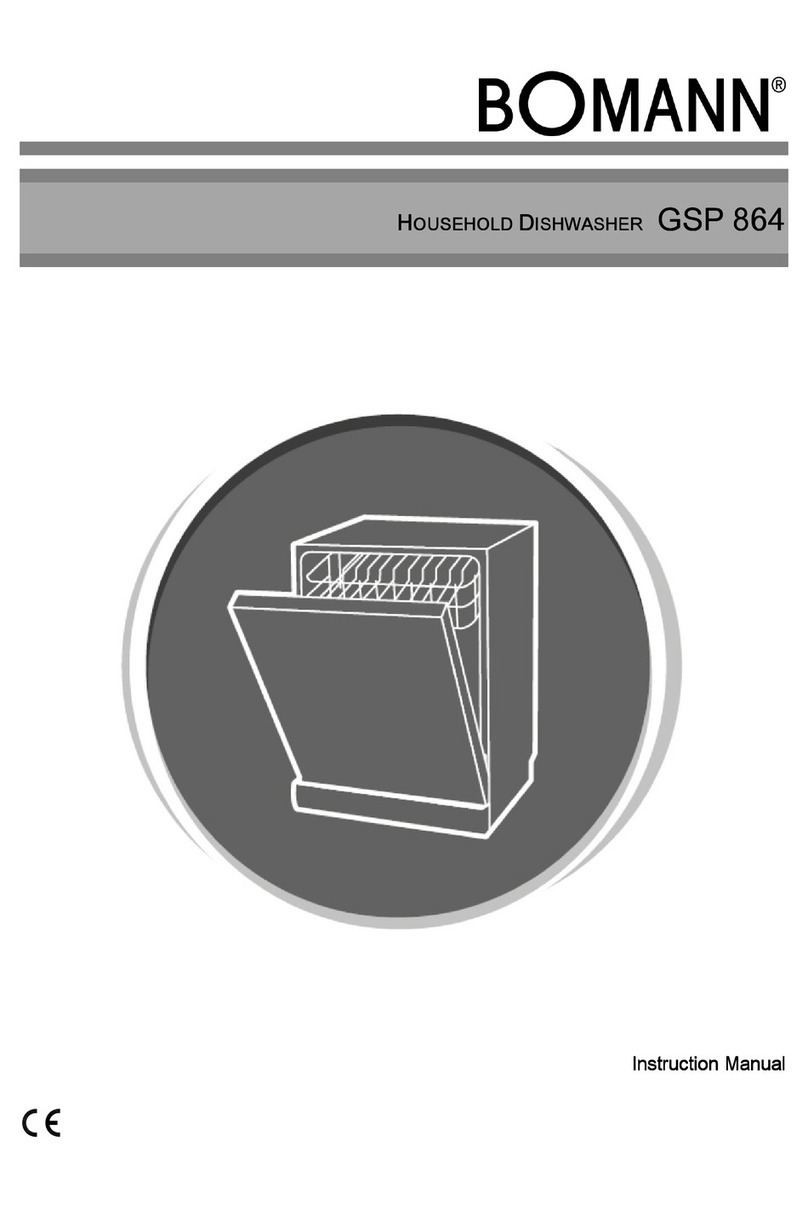
BOMANN
BOMANN GSP 864 User manual

BOMANN
BOMANN GSP 855 User manual
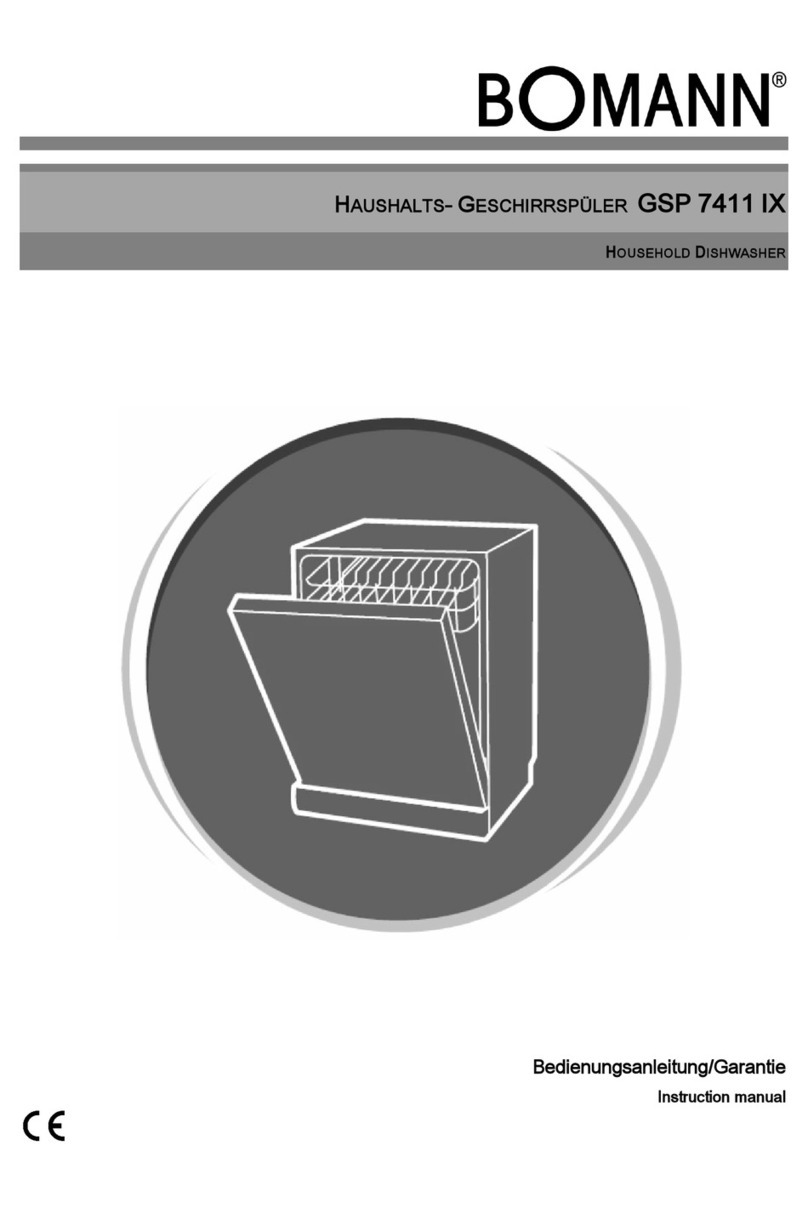
BOMANN
BOMANN GSP 7411 IX User manual

BOMANN
BOMANN TSG 7402 User manual

BOMANN
BOMANN TSG 5701 User manual

BOMANN
BOMANN GSP 7406 User manual
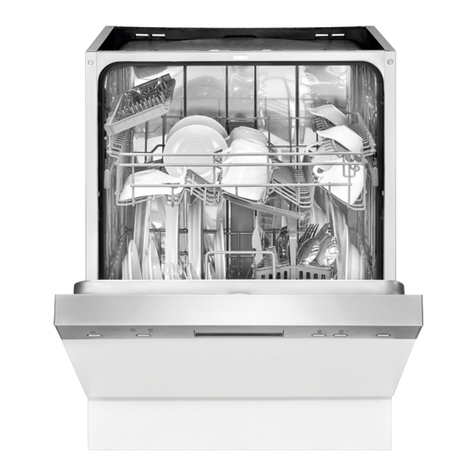
BOMANN
BOMANN GSPE 7414 TI User manual
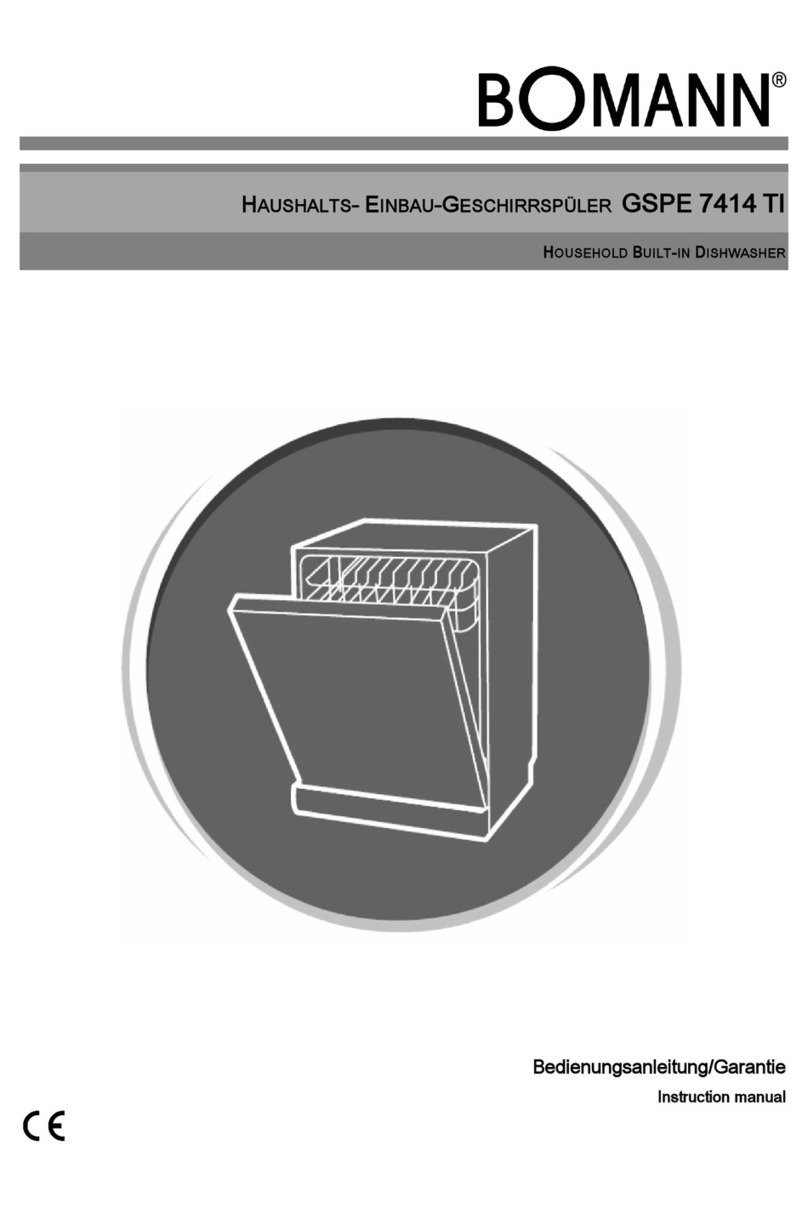
BOMANN
BOMANN GSPE 7414 TI User manual
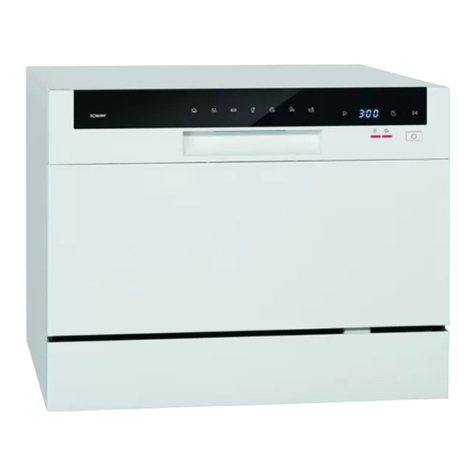
BOMANN
BOMANN TSG 709 User manual

BOMANN
BOMANN GSPE 7415 VI User manual
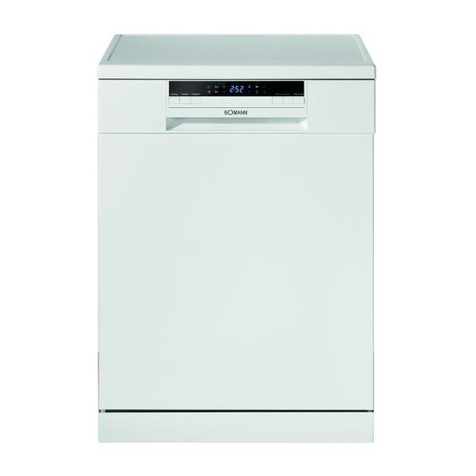
BOMANN
BOMANN GSP 853 User manual
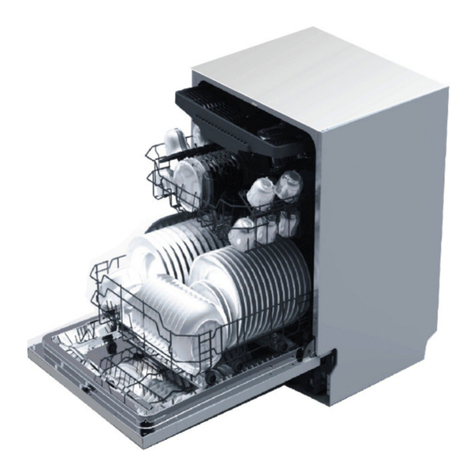
BOMANN
BOMANN GSPE 872 User manual
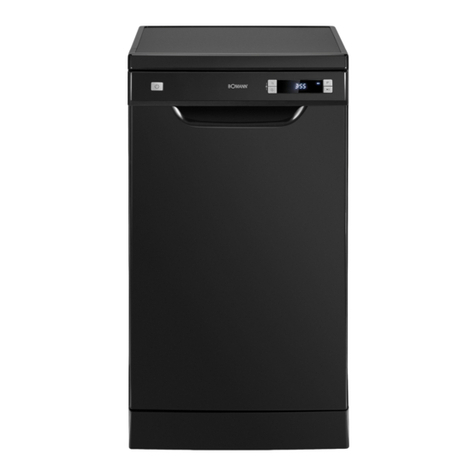
BOMANN
BOMANN GSP 7407 User manual
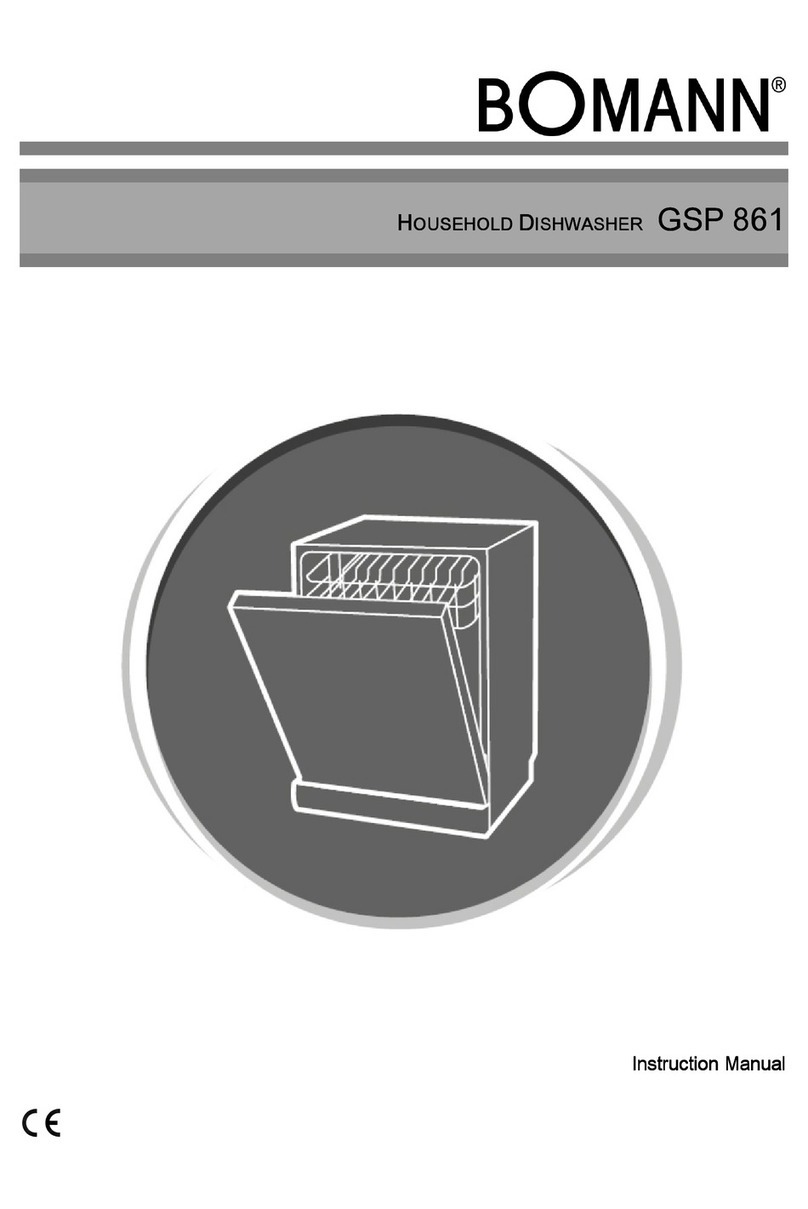
BOMANN
BOMANN GSP 861 User manual
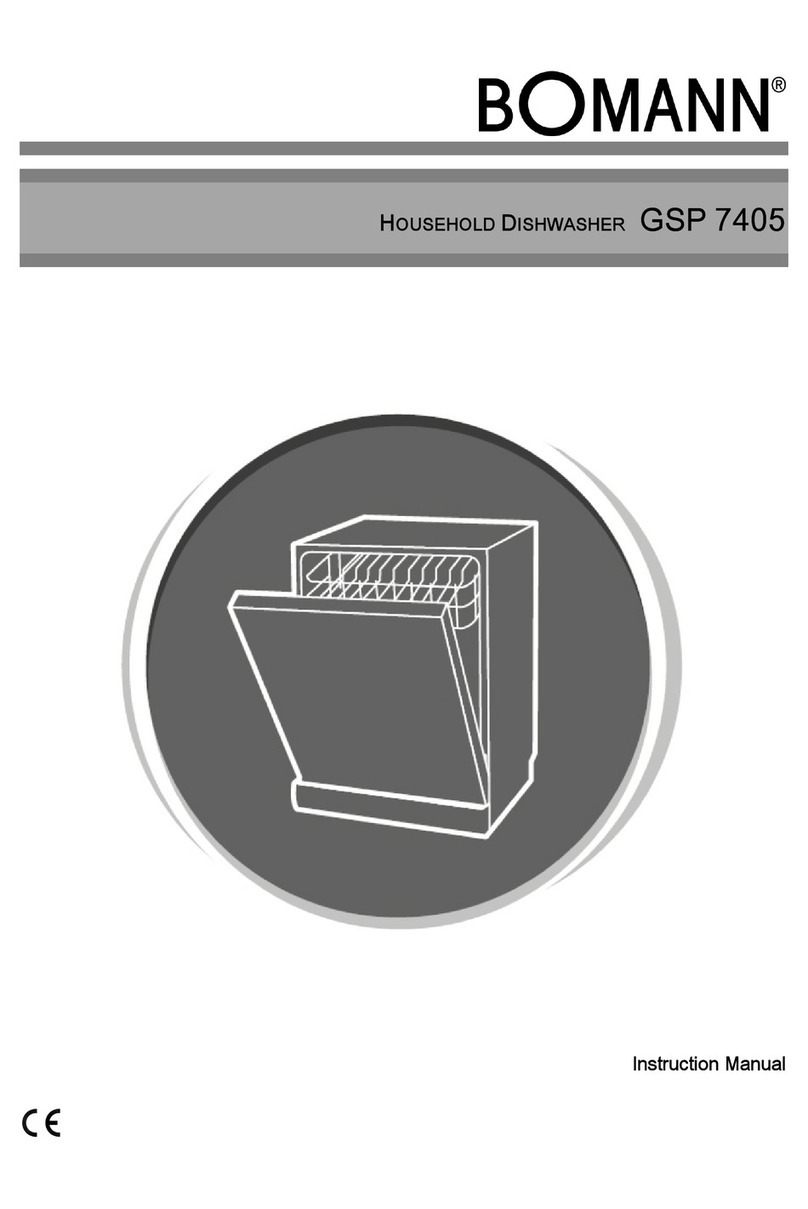
BOMANN
BOMANN GSP 7405 User manual
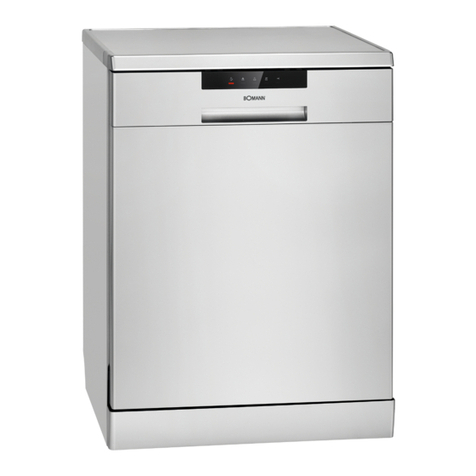
BOMANN
BOMANN GSP 7410 User manual

BOMANN
BOMANN TSG 7404 User manual

BOMANN
BOMANN GSP 7410 User manual

BOMANN
BOMANN TSG 707 User manual
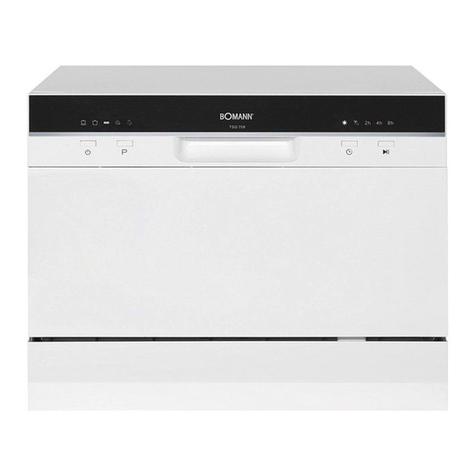
BOMANN
BOMANN TSG 708 User manual

